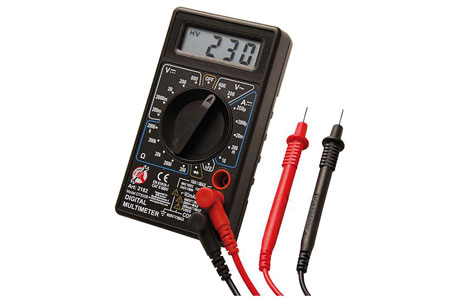How Accurate Is A Multimeter?
Key Takeaway
The accuracy of a multimeter indicates how closely its measurement matches the actual value. For digital multimeters (DMMs), accuracy is typically within ±0.5% to ±1% for quality models. This means if the actual voltage is 120V, the reading could range from 118.8V to 121.2V. Higher-end DMMs with more digits, like four and a half digits, provide greater precision.
Analog multimeters, which use a needle display, are less accurate, typically within ±2%. The required accuracy depends on the application. For simple tasks like checking if an outlet is energized, ±3% accuracy is enough. However, for more critical applications like calibrating medical, automotive, or industrial equipment, a multimeter with higher accuracy is essential. Always choose a multimeter suited to the precision needed for your work.
Factors That Determine the Accuracy of a Multimeter
The accuracy of a multimeter depends on its design, components, and calibration. Understanding these factors can help you choose the right tool for your needs.
Key Determinants of Accuracy:
Resolution and Sensitivity: A higher resolution allows the multimeter to detect smaller changes in electrical parameters, while sensitivity ensures the device can measure low signals accurately.
Internal Components: High-quality components, such as precision resistors and capacitors, reduce errors and improve accuracy.
True RMS Capability: For AC measurements, a True RMS meter provides accurate readings for both sinusoidal and non-sinusoidal waveforms.
Calibration: Regular calibration aligns the multimeter’s readings with known standards, maintaining accuracy over time.
For new engineers, investing in a multimeter with high resolution and True RMS functionality ensures reliable results, especially in complex electrical environments.

Accuracy Standards: What Do the Specifications Mean?
Every multimeter comes with accuracy specifications listed in its manual or on its datasheet. These numbers can seem confusing at first, but they’re crucial for understanding the device’s capabilities.
Typical Accuracy Specification:
Accuracy is often expressed as:
text{Accuracy} = pm (text{% of Reading} + text{Digits})
For example, if a multimeter has an accuracy of ±(0.5% + 2 digits):
0.5% of Reading: If you measure 100V, the error could be up to 0.5V.
2 Digits: Add or subtract 2 from the least significant digit in the reading.
Ranges and Accuracy:
Multimeters have different accuracy levels depending on the measurement range. Voltage measurements typically have the highest accuracy, while current and resistance measurements might be less precise.
Understanding these standards allows you to interpret your readings accurately and select the right multimeter for your application.
What Do the Specifications Mean? H2: How to Test and Verify Multimeter Accuracy
Regularly testing your multimeter’s accuracy ensures it remains a reliable tool. Here’s how to verify its performance:
Steps to Test Accuracy:
Use a Reference Source: Obtain a calibrated reference voltage, current, or resistance standard.
Set the Multimeter: Choose the appropriate range and function for the test.
Take Readings: Measure the reference source with the multimeter and note the readings.
Compare Values: Compare the readings with the known reference values. Any significant deviations indicate a need for recalibration or repair.
Tools for Verification:
Voltage Reference Standards: Precision voltage sources with known outputs.
Resistance Decade Boxes: Devices that offer adjustable resistance with high accuracy.
For engineers, making this a regular practice ensures your multimeter stays accurate, especially in professional environments where precision matters most.
How to Test and Verify Multimeter Accuracy H2: Environmental and User Factors That Affect Accuracy
Even a high-quality multimeter can give inaccurate readings if environmental or user factors are overlooked.
Environmental Influences:
Temperature: Extreme heat or cold can affect the internal components of the multimeter, leading to errors.
Humidity: Excess moisture can cause electrical leakage, impacting the readings.
Electromagnetic Interference (EMI): Nearby electrical equipment can introduce noise, distorting the measurements.
User-Related Factors:
Improper Probe Connection: Loose or incorrect probe placement can result in fluctuating readings.
Wrong Range Selection: Setting the multimeter to the wrong range may cause overload or inaccurate results.
Inconsistent Handling: Shaking or moving the probes during measurement can lead to errors.
To mitigate these factors, always work in a stable, controlled environment and handle the multimeter with care.
Environmental and User Factors That Affect Accuracy H2: Tips for Improving Multimeter Accuracy During Measurements
While a multimeter’s specifications set its baseline accuracy, following best practices can improve the reliability of your readings.
Practical Tips:
Start with Calibration: Ensure the multimeter is calibrated to align with recognized standards.
Choose the Right Range: Begin with the highest range if you’re unsure of the parameter’s value, then narrow it down for precision.
Minimize Environmental Interference: Conduct measurements in a stable environment, away from temperature fluctuations and EMI.
Inspect Probes Regularly: Check for damage or wear on the probes, as faulty connections can compromise accuracy.
Average Multiple Readings: Take several readings and calculate the average to account for random errors.
These tips help maintain the accuracy of your multimeter, ensuring reliable results in every measurement scenario.
Conclusion
The accuracy of a multimeter depends on its design, specifications, and how it’s used. By understanding the factors influencing accuracy, testing your multimeter regularly, and adopting best practices, you can ensure precise measurements every time.
For engineers, accuracy isn’t just about numbers—it’s about trust. A well-maintained and correctly used multimeter is a reliable partner in diagnosing and troubleshooting electrical systems. Prioritize calibration, careful handling, and environmental control to get the most out of this essential tool.

